INDUSTRIAL &
TERMINAL RAILROADS &
RAIL-MARINE OPERATIONS
OF BROOKLYN, QUEENS, STATEN
ISLAND, BRONX &
MANHATTAN:
HARLEM
STATION & RAILROAD
Mott Haven, the Bronx
ERIE / ERIE LACKAWANNA RAILROAD
E RR / EL / Bronx Terminal / Harlem River / East 149th Street Terminal
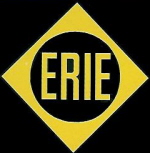

.
updated: |
||
|
|
||
update summary: |
date: | chapter: |
| 1935, 1947, 1951 Sanborn Fire Insurance Maps added |
01 January 2023 | Property & Facilities |
.
.

| Property & Facilities | Businesses | Operations | |
| Employees | Float bridge | Locomotive Overview & Photos |
|
| Locomotive Roster builders data, disposition info |
Memorabilia | ||
.. ..
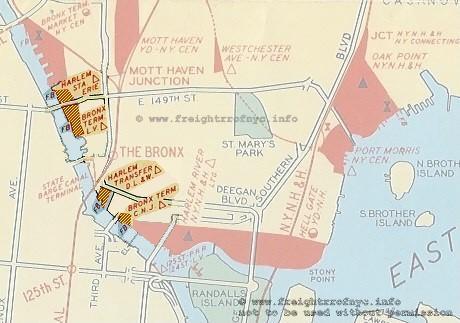
Port of New York Authority
New York Harbor Terminals, July 1943
.
.
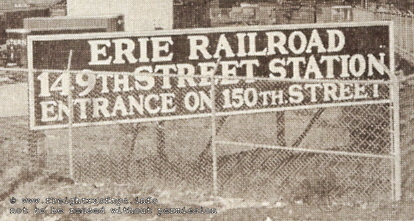
The Erie Railroad constructed the last of the terminal stations to be located along the Harlem River in 1927. This facility would also be the northern most offline terminal located along the Harlem River.
The Erie Railroad Harlem Station facility was located between East 149th and East 150th Street, Exterior Street and Harlem River.
The Erie Railroad was not new to operations in the Bronx, as it had originally utilized the shared Harlem Transfer facility along with the Central Railroad of New Jersey, Baltimore & Ohio and the Delaware, Lackawanna & Western Railroads prior to 1906. It was at that time the Delaware, Lackawanna & Western purchased the sole operating rights for that facility, leaving the other railroads to build their own terminals along the Harlem River.
Being the newest facility, it was also the most modern. But, as modern as this facility may have been, it was also spartan, despite its close proximity to the Bronx Terminal Market and the extremely busy Farmers Square.
In 1960, the Erie Railroad merged with the Delaware Lackawanna & Western Railroad, forming the Erie - Lackawanna.
The Erie Railroad / Erie Lackawanna Railroad Harlem Station operated until 1969.
.
.
The Erie Harlem Station facility consisted of spacious modern freighthouse (considered modern in 1952!), an electric overhead gantry with 30 ton capacity, auto unloading platform with concrete ramp and wide concrete driveways.
The property foot print was not large and asymmetrical, being somewhat pentagonal in shape.
The property foot print was roughly 487 feet by 350 feet.
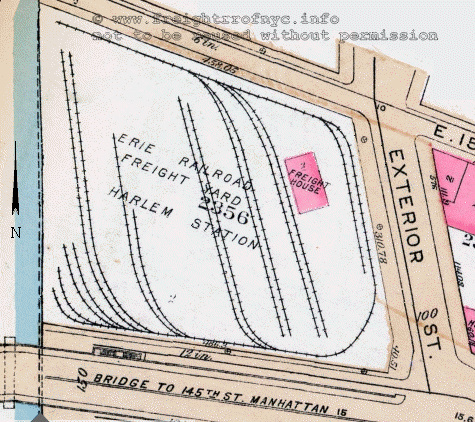
G. W. Bromley Property Map -1928
.
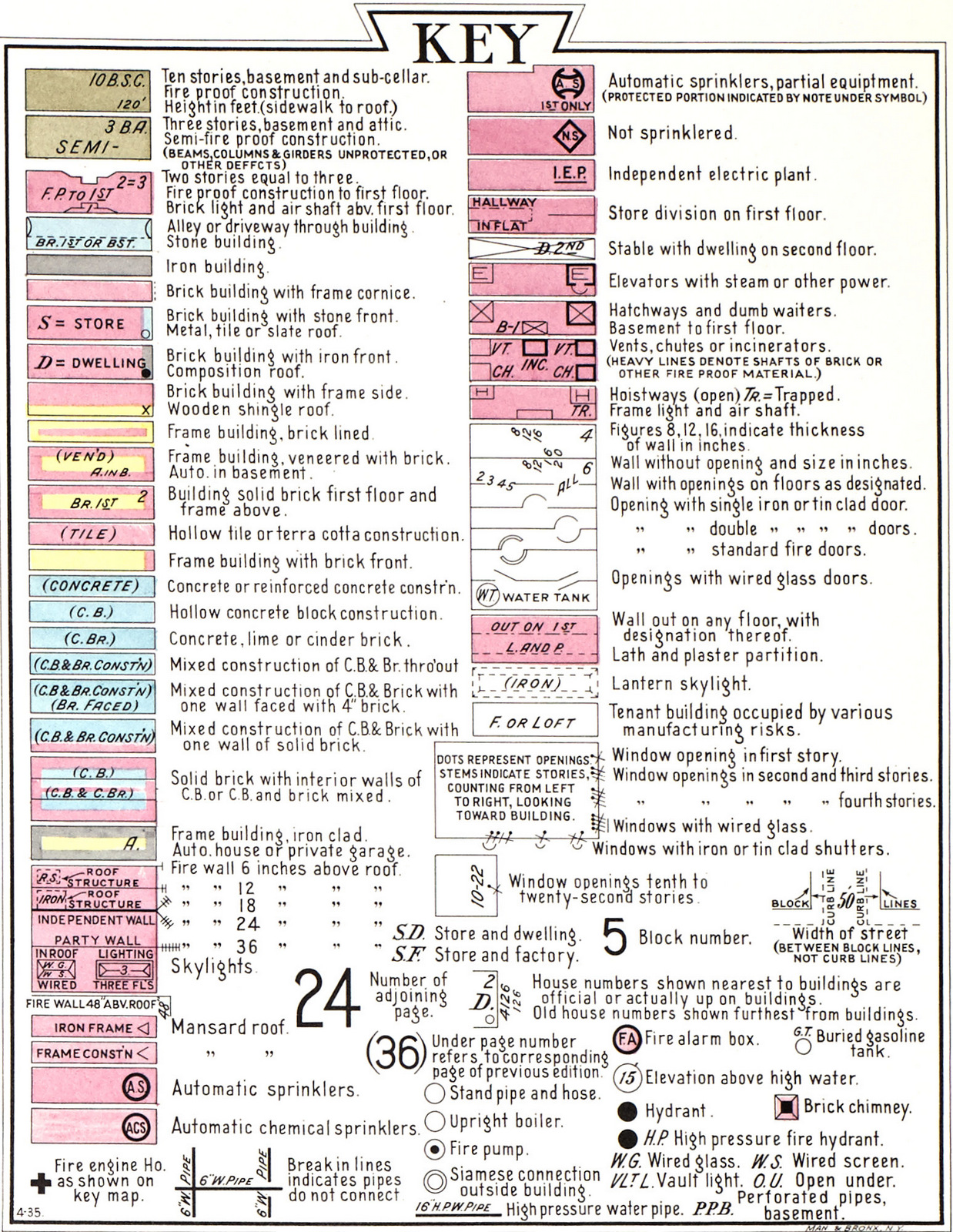 | 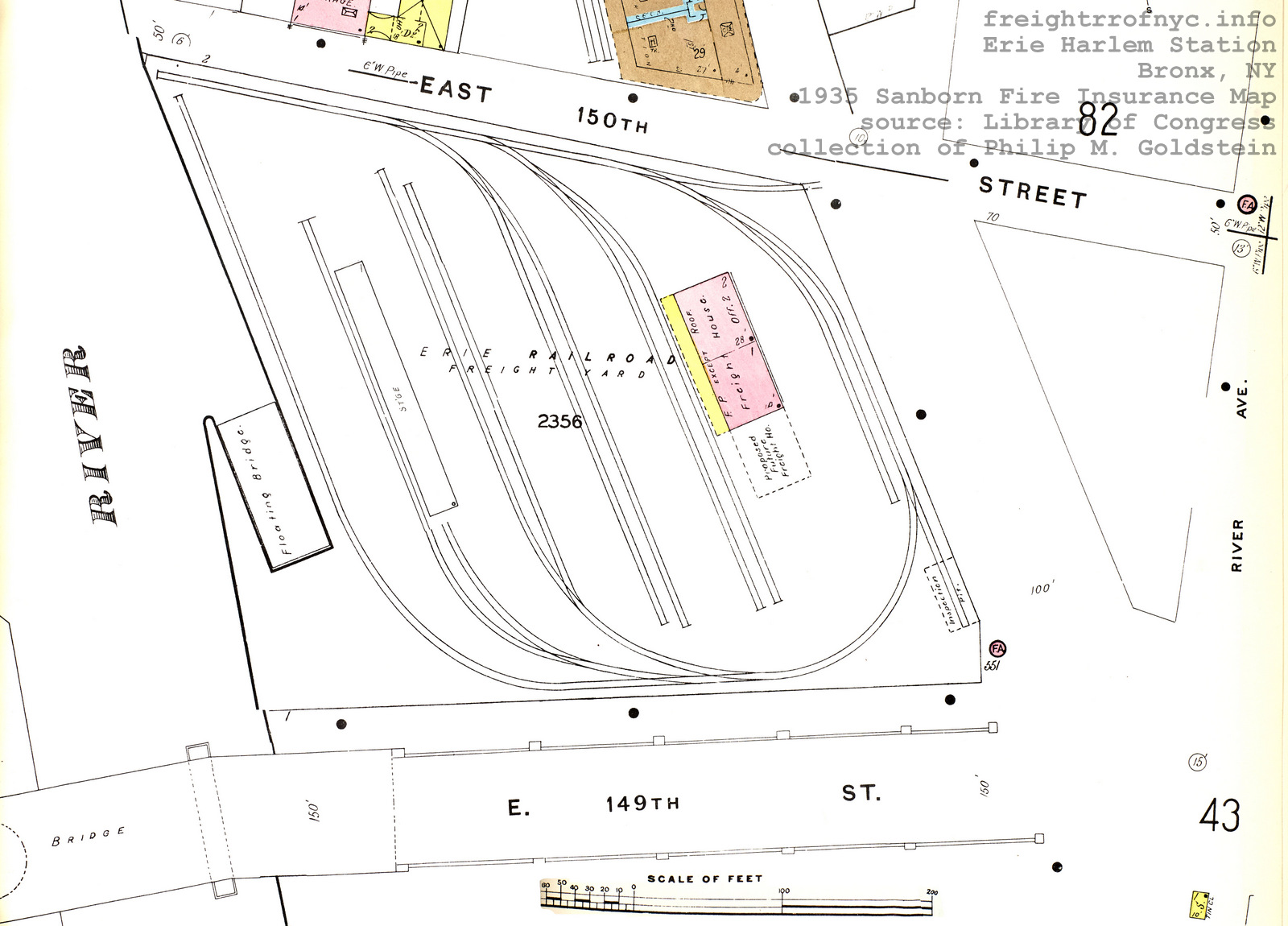 |
| Sanborn Fire Insurance Map - 1935 Library of Congress authors collection added 01 January 2023 | |
| . | |
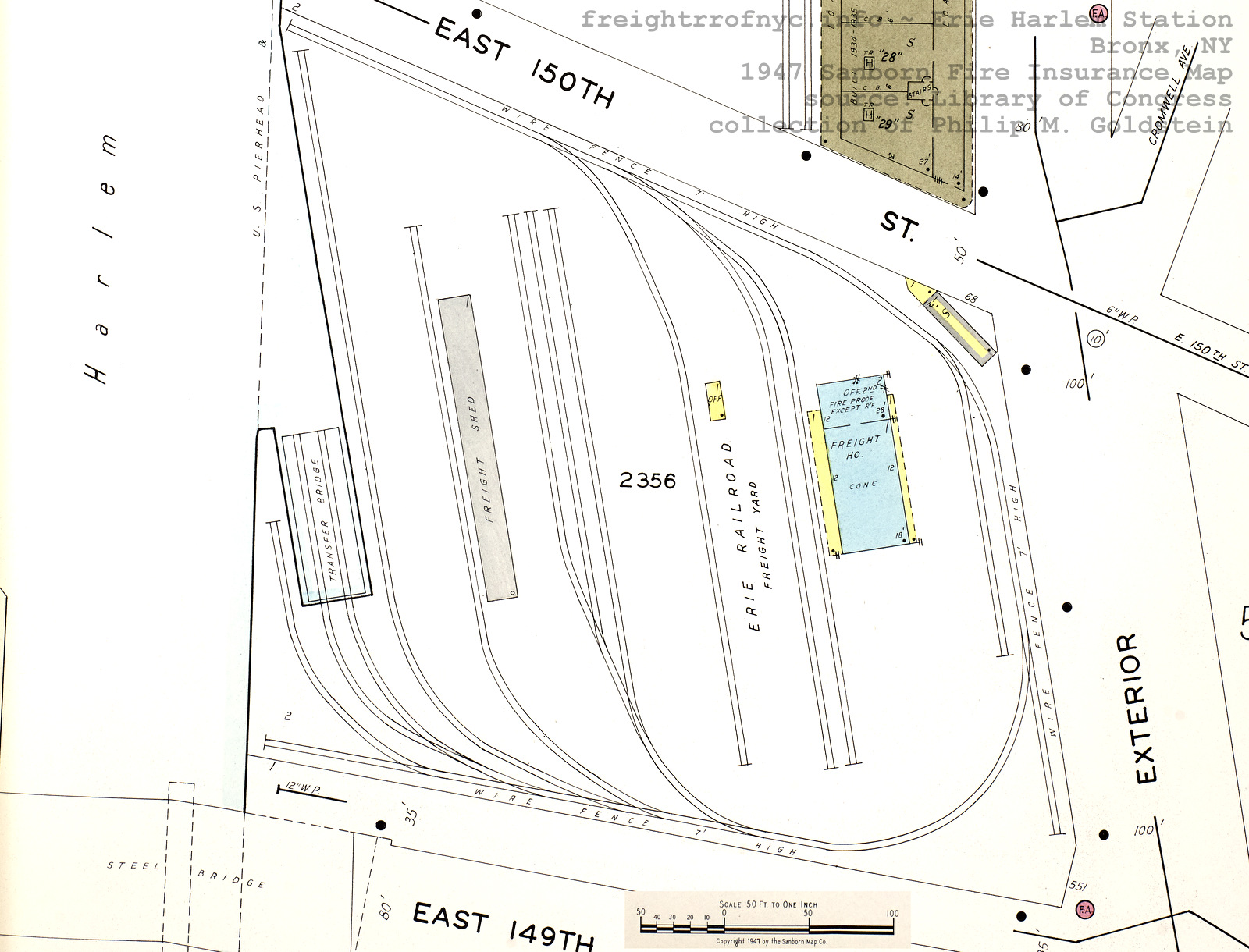 | 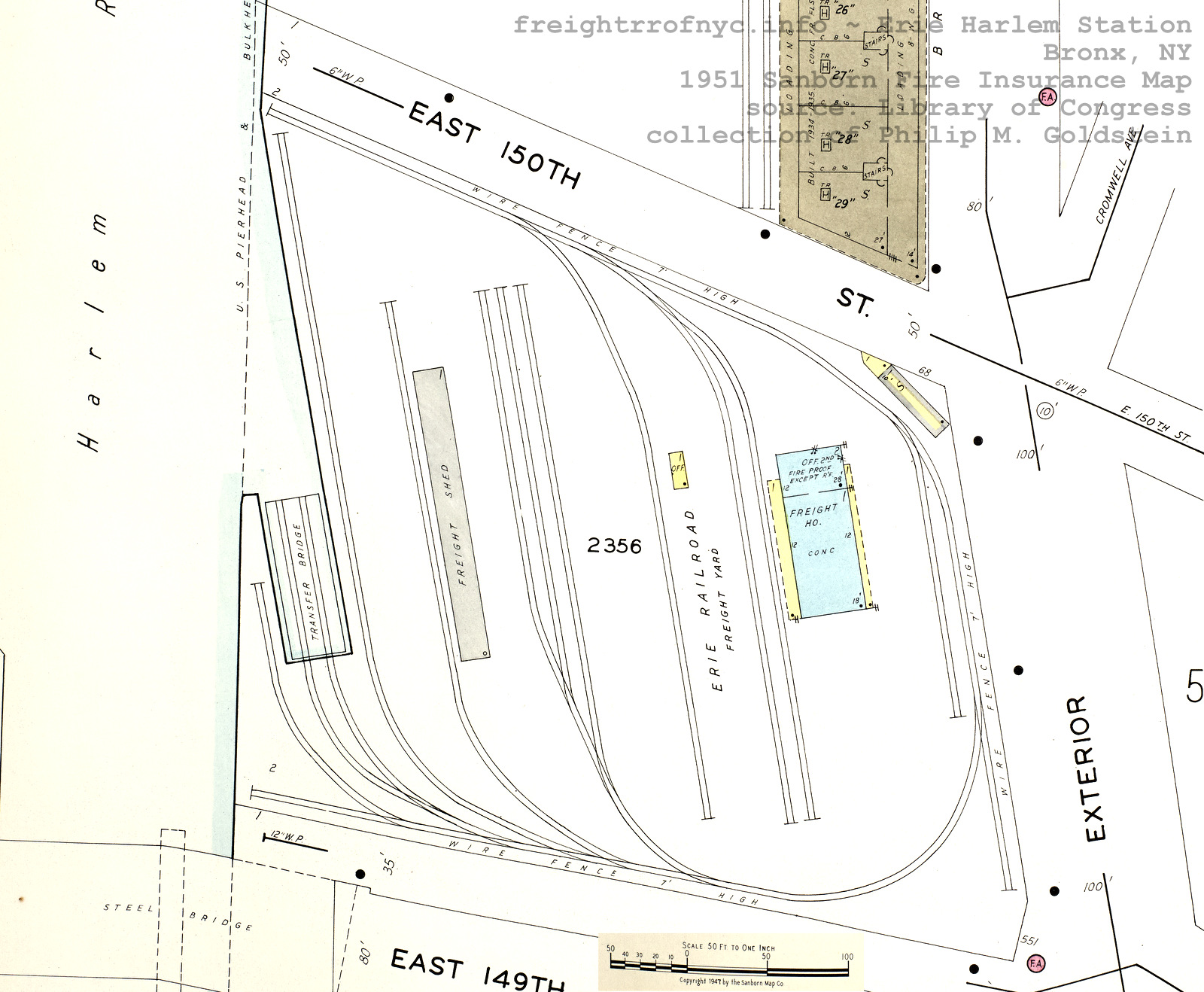 |
| Sanborn Fire Insurance Map - 1947 Library of Congress authors collection added 01 January 2023 | Sanborn Fire Insurance Map - 1951 Library of Congress authors collection added 01 January 2023 |
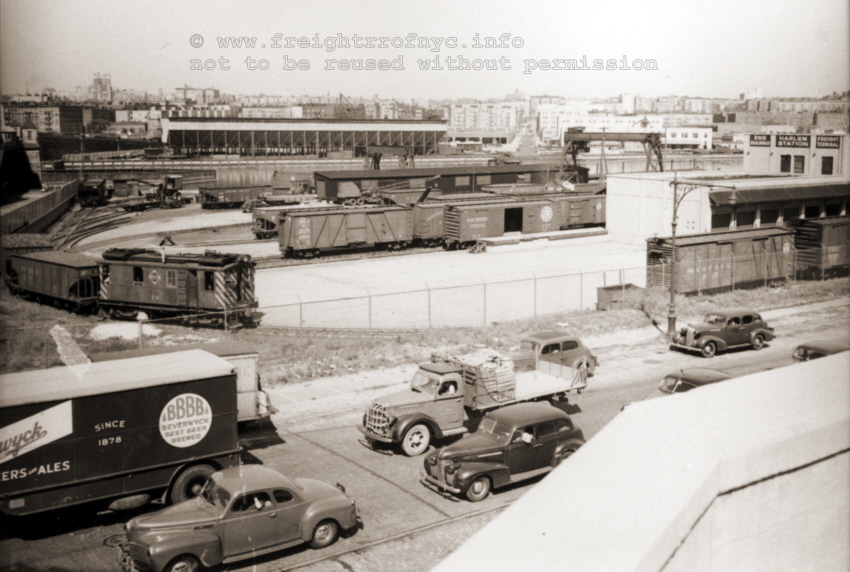
Erie Railroad Bronx Terminal - ca. 1940
(looking west with Manhattan in background)
J. Long photo
D. Biernacki collection
J. Held archives
added 13 July 2009
.
.
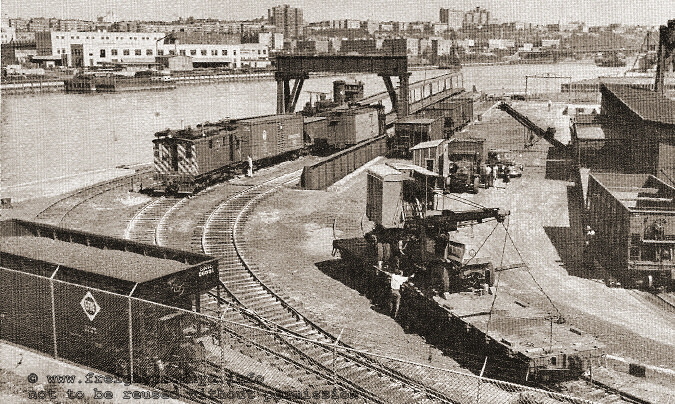
unknown date
Track Planning for Realistic Operation, Second edition, by John
Armstrong
Kalmbach Publishing
added 07 February 2010
The lack of structures on this property, other than that of the freighthouse, leads the author to believe that the individual businesses as mentioned above utilized dedicated sidings in the main yard, as opposed to spur tracks leading to the various structures common to the other facilities in the Bronx.
In the photo below, a portion of the freighthouse can be behind the sign.
.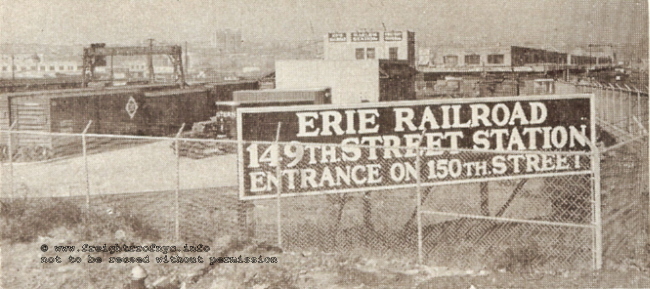
ca. February 1952
(looking north)
Erie Railroad Magazine - February 1952 issue
added 20 Jan 2009
.
.
Paul Strubeck located the following 1957 Fairchild Aerial Survey Photo in the New York State Library Digital archives. While not as large as some of the other Fairchild Aerial Survey Photos, it gives us a good visual representation of the property layout.

.
.
With many thanks to Matt Herson for furnishing the following image, which shows a nice elevated view of the Harlem Station Yard in April 1968.
In this view, (looking north northeast) we can a truck crane (minus boom) on a flatcar by the concrete unloading ramp on the second from left track. Judging from the cleanliness of this piece of equipment, I think it would be a fair guess that it is inbound, and scheduled to be unloaded for a customer.
On the left most gantry track, there appears to be a red lattice type structural steel in the gondola. Closer examination of the image reveals this object to be a part of the boom for the truck crane on the flatcar!
Directly above the cab roof of the locomotive, is a red cabbed "straight job" truck, with "BAY" on the box. This would mean Bay Transportation, a tenant of the Harlem Station.
The long white structure, that runs from the right edge of the image to and under the the gantry, is the Bronx Terminal Market. The horizontal gray structure just above that, is the elevated portion of the Major Deegan Expressway "I-287").
If one looks carefully to the right of the beige multi-story brick warehouse behind the expressway, the newly painted (painted white in 1967) facade and stadium lights can be seen of the "old" 1923 Yankee Stadium can be seen, before it was vacated to be modernized in 1973 through 1976. Who knew both the Stadium and the Harlem Station would be gone by 1976?
No doubt that we owe Matt a great deal of thanks for capturing two iconic Bronx landmarks in this image!
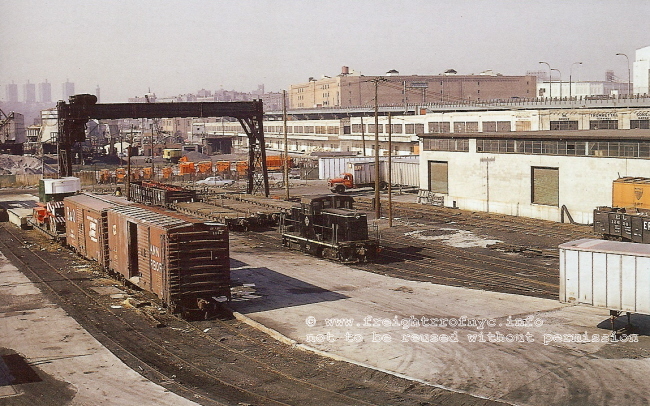
Harlem Station Yard - April 1968
M. J. Herson photo
M. J. Herson archives
added 01 Apr 09
..
The following information regarding the closure of the Harlem Station was generously submitted by Gordon Davids on 23 December 2009:
"The last year of operation was 1969. I was the Asst. Division Engineer at Hoboken when it shut down. I went over there to start an inventory of track material for the retirement AFE, and I couldn't do a thing. The whole place was buried under construction debris. As soon as the last EL employee had left, the gypsy haulers knocked down the gate and saved themselves all the miles and tolls they would spend hauling the stuff to a legal dump in New Jersey."
The February 1952 issue of Erie Railroad magazine listed the following tenants served by the Harlem Station:
| Bay Transportation | < 1952 > |
| Jerome Fuel Co. | < 1952 > |
| Mirandi Coal Co. | < 1952 > |
| National Carloading | < 1952 > |
| Adolf Gobel (future tenant) | 1952 > |
| Gerosa Crane? | |
| United Cigar Box | |
| HudFord | |
| Brill |
The following was submitted to me via email from Nick Panebianco on April 8, 2009; following his offer of information when he signed the guestbook of this website:
What I have are stories I’ve been told, some names of people and companies and some things I witnessed myself. For example:
"Interesting that in your Erie info a new crane is being delivered. It looks to be in the distinctive livery of Gerosa Haulage Company, a well known New York City institution which was headquartered in the Bronx. In fact Gerosa bought the CNJ property when CNJ left and it remained derelict for several years until they built a state of the art crane servicing facility on the site of the CNJ operation south of Third Avenue.
North of Third Avenue CNJ served the United Cigar Box Co, HudFord, and Brill among others. As a kid, I was fascinated by the rails embedded in cobblestone between the buildings with nearly no clearance on either side of the cars.
Our family hauled coal from Miranda, and Blue Ridge, & Cramer which were on the Harlem Transfer. Miranda was cut off from barge shipments when the Mott Haven Canal was filled in, and then from Harlem Transfer rail service when the Major Deegan Expressway was built cutting off the east end of the tracks. It ended its life as a truck in / truck out facility in the 1980’s.
Weber, Bunke & Lange which was a CNJ customer, Streat, Stokes, Bradley-Mahoney and Central were all Lehigh Valley customers (I think).
I was fascinated to learn that there were no connections to neighboring railroads, especially since the Bronx Terminal Market was so close to Erie Railroad, and New York Central and Central Railroad of New Jersey only had to cross about 50 feet of Lincoln Avenue for a direct route to New England and beyond."
.
.
According to the February 1952 issue of Erie Railroad Magazine, there would be a daily tugboat trip.
It should be noted that terminals located in the Bronx were imposed with physical restriction on the transport of carfloats. One must consider the narrow width of the channels between the swingbridge center island fender and end abutments. Therefore any tugboats transporting carfloats to any of the terminals located in the Bronx, would have to transport those carfloats singly.
An inbound carfloat loaded with freight would be dropped off, and the tugboat would return to New Jersey with a carfloat of empty freight cars that had been unloaded he previous day and or with cars loaded with outbound freight.
Inbound commodities such as: canned goods, heavy construction equipment, feed, grain, furniture, steel pipe, rugs, lumber and evaporated milk are listed as having been consigned through the Harlem Station. Another of the significant inbound commodities was coal.
Outbound freight consisted of waste paper, rags, machinery and conveyors.
In 1960, the Erie Railroad would merge with the Delaware, Lackawanna & Western Railroad, thus forming the Erie - Lackawanna Railroad. Due to this merger, the Harlem Station and Harlem Transfer Company would be both operated by the Erie - Lackawanna Railroad.
Incidentally, the Erie Railroad Harlem Station may have long since been demolished, but one gantry on the former property survives to this day, and was photographed by Vince Lee:
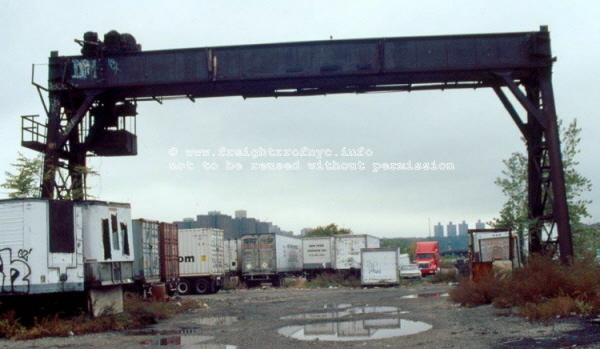
December 12, 2002
Vince Lee photo
.
.
One of the benefits of "internal" publications, such at the Erie Railroad Magazine, is the amount of information on the employees mentioned.
The Harlem Station in 1952 had employee roster of 12 people. Upon reading the article in the February 1952 issue of Erie Magazine, it was ascertained that all employees at the Harlem Station were veteran Erie Railroad employees, with an aggregate of 28.25 years experience among the men. The "newest" man stationed at the Harlem Station, was a veteran of the Erie Railroad for 9 years.
The freight agent, John J. Dillon; has been at the Harlem Station for 23 years and with Erie Railroad for 49 years! In todays mindset of "putting in your 20 (or 25) years and getting out"; it is astounding to think that Mr. Dillon has been working for the same company for almost half a century!
|
Employee Roster - Erie RR Harlem Station, 1952
|
.
Trackage at this facility would be compact, and simplistic when compared to the other three Bronx offline facilities.
The track layout at this facility would differ from the other three Harlem River offline terminals, in that it would not have a concentric circular track plan or circular freight house. This track configuration can best be understood by viewing the Port Series Map below:
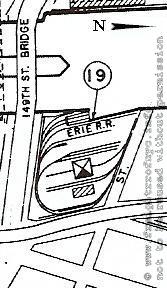
Army Corp of Engineers Port Series Map
.
.
According to Erie Railroad Magazine, Vol. 47, No.12, February 1952; this yard consisted of 10 tracks with a capacity of 55 cars.
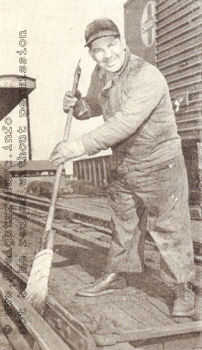
ca. February 1952
Erie Railroad Magazine - February 1952 issue
roving trackman Angelo
Guibelo
added 20 Jan 2009
.
.
The floatbridge orientation in the Port Series Map below shows that it was parallel with but at a slight angle to the Harlem River. This would allow maximum clearance to river traffic as well as ease of bridging or unbridging of the float.
While not illustrated in the G. W. Bromley Maps above, the trackage configuration does not appear to have changed much throughout the intervening years, so it is believed that this float bridge configuration was unchanged from date of construction in 1927.
The float bridge pictured at this location in the 1952 Erie Railroad magazine is pontoon type steel pony plate girder with overhead gantry..
Judging from historicaerials.com aerial photos, and from images in "New York Harbor Railroads in Color" by Tom Flagg, this float bridge was located at this facility throughout the entire history of this terminal.
The unique feature of this float bridge was that it retained its overhead gantry throughout its usage. This gantry was used to both raise the float bridge for maintenance and for carfloats riding high in the water eliminating the need for a float bridge jack.
 .
.
ca. February 1952
Erie Railroad Magazine - February 1952 issue
added 20 Jan 2009
.
From photographic references, we know of at least four locomotives assigned to the Erie Railroad Harlem Station facility.
The first locomotive that is known about and as pictured in the Erie Railroad Magazine of February 1952; is an oil-electric boxcab. Unfortunately, the number of this locomotive is indiscernible in the photos, but appears to be a 60 ton ALCo/GE/IR locomotive, similar to the models used at Bronx Terminal of CRRNJ and Harlem Transfer.
.
#20 & #19
Erie Railroad #20 was a 60 ton oil-electric boxcab locomotive that was built in 1926 by American Locomotive / General Electric / Ingersoll Rand. This locomotive was the sixth oil-electric boxcab in a long line of boxcabs constructed by A/GE/IR, following the success of CNJ #1000 boxcab built the previous year.
As the Harlem Station opened in 1927, it is very likely that #20 was the first locomotive to serve at the Harlem Station, but this is unconfirmed at this time.
Interestingly, while viewing these images, this author
took note of some discrepancies regarding the safety stripes on the ends
of the locomotive. According to Sam Berliner's website, the safety stripes
were added between 1935 and 1938.
If one views the 1926 builders photograph of #20, "E R I E" is spelled out along the sides of the locomotive, and there are no safety stripes are on the ends.
In the 1935 photo, the locomotive now sports the Erie "diamond logo", but still no safety stripes on the ends.
In the 1938 photo, the locomotive now has the Erie Diamond logo and safety stripes on the ends.
In the February 1952 photo, clearly shows the locomotive to have the spelled out version of "E R I E" (as in 1926 photo - the last "E" above and to the left of conductors shoulder) AND the locomotive has safety stripes!
Upon discovering these discrepancies, this author requested the keen eyes of Paul Strubeck to look the images over. Paul immediately noticed that the grab irons on the locomotive in the 1952 photo to differ from the other images:
The grab iron over the coupler cut bar in the 1952 photo has looped ends, while the grab irons in the other photos are stub end. Also, the grab iron for the cab steps in the 1952 photo, the bottom fastening point is the bottom of the car body. In the other photos, it is the bottom of the frame!

These subtle differences led this author to believe that the locomotive in the February 1952 images is Erie #19 and not #20. Referencing the December 1970 issue of Trains Magazine, which contains a very lengthy feature article on AGEIR locomotives, revealed that #20 and #19 has slightly different body styles: #20 was constructed with a B3-3 body and #19 was constructed with a B3-4 style body.
While this would explain the subtle differences seen between the different photos, there remained no way to confirm this through the Trains article as there were no accompanying images of # Erie19! Sam Berliner's boxcab website did not contain an image of Erie #19 neither. So, after some consideration, it was thought to check another AGEIR locomotive with a B3-4 style body.
Upon further review of the December 1970 Trains article, it was learned that Chicago & North Western #1002 was also a 66 ton model constructed with a B3-4 type carbody, so CNW #1002 was identical to Erie #19, and fortunately Sam Berliner has a great photo of CNW #1002 on his website!
Well, to make a short story long, photos of Erie #19 (also B3-4 car body) show it also had those looped grab irons. Considering this information, a very strong case now exists that Erie #19 worked at the Harlem Station as well.
Lapse forward to May 2009 when I acquire a scanned image of #19 actually working at the Harlem Station. It is now conclusively proved that both #19 and #20 would see service at the Harlem Station.
However, photos obtained from Jay Held in July 2009, shows #19 with ball end grab irons! What the hell is going on here??? This would make #19 being built as a B3-3, and not a B3-4 under my reasoning. But this is not the case as the builders records clearly show #19 as a B3-4 and also being 66 tons, as opposed to 60 tons for #20.
So it simply appears the grab irons were changed by Erie and are not truly indicitive of the body type on the locomotive.
.
.#320
Another locomotive known to have operated at this facility were Erie #320. This locomotive was an American Locomotive Company model S1, built in April 1950.
Matt Herson's photographs below show this locomotive in use at this facility in January 1961, but it is uncertain if this locomotive was permanently assigned to the Harlem Station and if so from and during what dates, until the next locomotive seen at this facility below.
.
#26
Erie #26 was a General Electric model 44 Ton locomotive. This locomotive was chronologically older than #320, but appeared at this facility after #320 in 1968. This locomotive was built in September 1946. Fortunately, Matt Herson captured this locomotive at this facility on film as well.
|
| .
. |
|
| .
. |
|
| .
. |
|
| .
. |
|
| .
. |
|
| .
. |
|
| .
. |
|
| .
. |
|
| .
. |
|
| .
. |
|
| .
. |
|
| .
. |
|
.
.
Harlem Station (ERR) Locomotive
Roster
| number / name | builder | c/n | build date |
gauge |
wheel arrangement |
model | driver dia. |
cylinders |
acquired |
disposition |
notes | ref |
| #20 | ALCo/ GE/IR |
66681/ 10024 |
5/25/1926 | std. | B-B | 60 ton boxcab |
new | retired & scrapped November 1958, Meadville, PA | body type B3-3 300 hp [a] |
[1] [20] [45] |
||
| #19 | ALCo/GE/IR | 66757/ 10137 |
9/1928 | std. | B-B | 66 ton boxcab |
new | retired October 1958 scrapped November 1958, Meadville, PA |
body type B3-4 300 hp |
[1] [20] |
||
| #26 | GE | 28504 | 9/1946 | std. | B-B | 44 Ton | new | unknown | in service 4/1968 | [b] | ||
| #320 | ALCo | 77979 | 4/1950 | std. | B-B | S1 | new | unknown | in service 1/1961 | [1] |
Locomotive Footnotes:
[a] |
Erie Railroad #20 was constructed first
in May 1926. Erie Railroad #19 was constructed in September 1928. Both locomotives were scrapped in November 1958. Both of these locomotives served at the Harlem Station. See notes in Locomotive chapter. |
| [b] | info from R. Craig and J. Komanesky rosters |
.
.
There were at least three tugboats regularly assigned to service the Harlem Station facility that we know about.
The tugboats, (like those of the Harlem Transfer operation), would be unusual in their own way. Because the Harlem Station was located on the Harlem River, which to this day; has low clearance road bridges spanning the waterway from Bronx to Manhattan, required "shorter" marine vessels to ply this waterway.
The bridges that were built were of movable type (mostly swing type), but in the early decades of the twentieth century when river traffic was heavy, would have required the road bridges to open very frequently throughout the day, and thereby disrupting vehicular traffic constantly.
To help ease this disruption, several tugboats would be modified with shorter smokestacks and lower wheelhouses to fit under the swing and vertical lift bridges along the Harlem River, so as not to have the bridges open up and impede the flow of vehicular / rail traffic as frequently.
Charles Gerow, a New York Harbor Pilot (retired) based out of Sandy Hook, offered this explanation:
"the [lower] tugs were used NOT to avoid impeding road traffic, but to avoid being hung up by an obstinant draw tender, particularly if you had a fair tidal current pushing you."
This explanation makes good sense too ,as it would not be well off for the tug crew (or the bridge tender!) to hit the drawbridge.
The following image shows the easily recognizable differences between a "Harlem River" tugboat (below left) which could navigate the Harlem River without requiring bridges to open, as opposed to a standard profile railroad tugboat (below right) which could not:

.
.
It should also be noted that terminals located in the Bronx were imposed with physical restriction on the transport of carfloats. One must consider the narrow width of the channels between the swingbridge center island fender and end abutments. Therefore any tugboats transporting carfloats to any of the terminals located in the Bronx, would have to transport those carfloats singly.
The three tugboats used for the Erie Railroad's Harlem River facilities were the "Chicago", "Rochester" and the "Cleveland".
In 1960, the Erie Railroad would merge with the Delaware, Lackawanna & Western Railroad, forming the Erie - Lackawanna Railroad. Due to this merger, Erie - Lackawanna tugboats and carfloats would service both the Harlem Station and Harlem Transfer facilities in unison.
|
| .
. |
|
| .
. |
|
| .
. |
|
| .
. |
|
| .
. |
|
.
...
Harlem Station (ERR / EL) Tugboat
|
||||||||||||||||||||||||||||||||||||||||||||||||||||||||||||||||||||||||||||||||||||||||||||||||||||||||||||||||||||||||||||||||||||||||||||||||||||||||||||||||||||||||||||||||||||
Tugboat Footnotes:
| [a] | purchased new by Erie Land & Improvement
Company for carfloat service in Chicago, IL in 1913 and named "Wauwatosa" (possible error - the Wauwatosa is also listed as a steam lighter), renamed: "C. S. Goldsborough", 1918; renamed: "Chicago" 1928; transferred to Erie Railroad Co., 1931; used until 1935 when it was sent East. O.O.S. 1949, repowered 1951 w/ Clevelend 12-278A, fuel cap'y 10,940 gal. transferred to Erie - Lackawanna RR Co., NY, 1961; |
| [b] | Engine: Compound, cylinders 18" & 38" bore x 30" stroke Boiler: Single Ended Scotch, 10.6' diameter x 14' length, 130 psi |
.
.
.
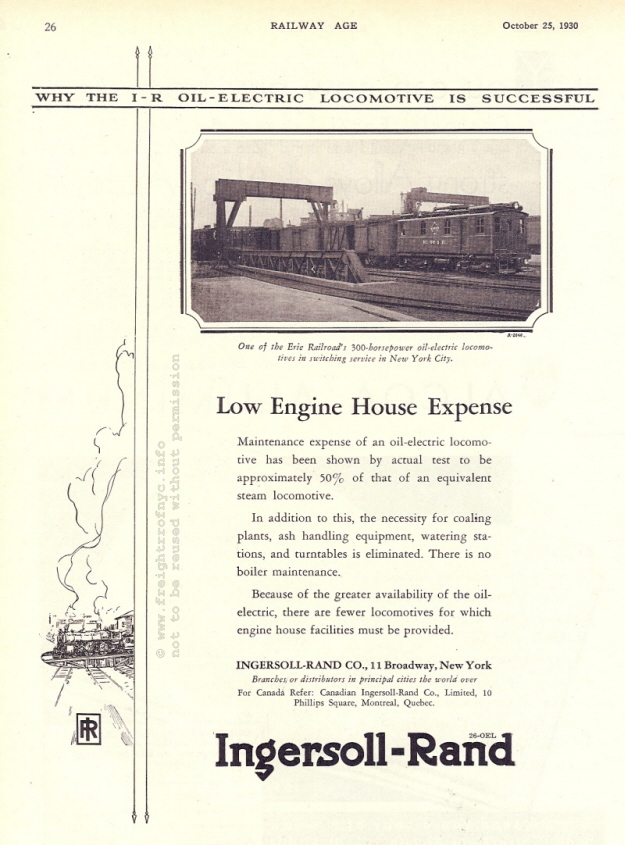
October 25, 1930 Issue of Railway Age
Caption for photo says "New York City", but that is the Harlem Station Float
Bridge, Float Bridge Gantry
and overhead Freight Gantry. While locomotive number appears to be airbrushed
out, it appears to be #20
judging by style of grip rails (ball end, not loop end)
authors
collection
added 02 February 2010
.
Like what you see? Suggestions?
Comments?